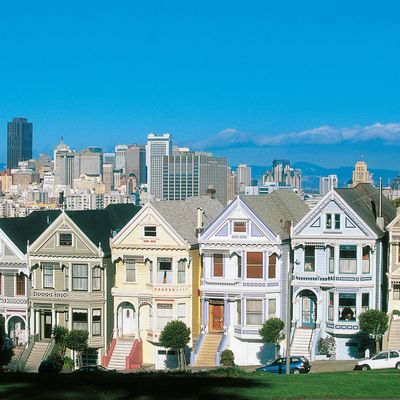
Recently, I was in San Francisco for work and remarked to a friend what a nice city it was to walk around in. Sunlight and fog bathe the three-story Victorians. Pocket gardens dot the hillsides. It’s charming — as charming as Greenwich Village or Brooklyn Heights in New York, if not more so.
These neighborhoods are adorable. They are desirable. And they are a total economic disaster.
That’s because those three-story homes in those cute neighborhoods house relatively few San Franciscans and New Yorkers, driving up housing prices, driving down density, and suppressing population growth. The city’s residents end up shelling out astronomical sums of money to live there. And far too few people get to join them. Everybody would be better off if developers could rip down those houses and build apartments and condos — and I mean everybody.
A new study by Chang-Tai Hsieh of the University of Chicago and Enrico Moretti of the University of California, Berkeley, calculates that the United States economy would be nearly 10 percent bigger if just three cities — New York, San Jose, and San Francisco — had loosened their constraints on the supply of housing and let more people in during the past few decades. Let that sink in: 10 percent bigger.
To get that number, the economists imagined a world in which those three cities had average land-use regulations, rather than the highly restrictive ones you see in practice. Over time, millions more workers would have flocked to those cities, becoming more productive and helping the whole economy grow. The average worker would be making $6,000 more a year than they are. Annual economic output would be more than $1 trillion higher as of 2009. We’d all be better off.
It’s an insane amount of money and highlights the real cost of policies like historical preservation, street-parking requirements, and height restrictions in cities like New York and San Francisco. Yes, they’re there in part to preserve local character. Yes, they’re there in part to keep cities beautiful. But they’re also there to preserve housing values for incumbent homeowners, at the cost of keeping out thousands and thousands of other residents, sucking up a huge chunk of the earnings of the households that do rent in those neighborhoods, and driving up prices everywhere else in the city.
And that’s just the well-known tradeoff in local terms — the important thing about this paper is that it underscores that the effect is national in scope. By jacking up housing prices and pushing workers to live in lower-productivity areas of the country, building restrictions mean a smaller economy. Think about that the next time you marvel at the window boxes on a cute brownstone.





























